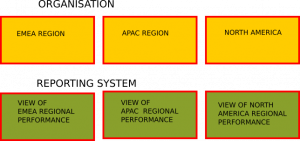Making sure your agency reporting contains compelling stories that engage your client, and build relationships is vital. It’ll help you upsell the next project. The following ideas are designed to help you do this.
1) Map the reporting onto the clients organisation.
Any global corporate has a complex structure. There are many regions, and product or service groups. Some of these will have come from past mergers and acquisitions.
So the individuals within the corporate have very different responsibilities and perspectives. And the reporting should reflect that.
Matching reports to responsibilities
Readers ignore reports that don’t help them deal with their own responsibilities. The challenge for an agency is to provide reports that every reader values highly.
Restricting the reporting to a small number of individuals is the wrong answer here. It deprives your agency of one of the most powerful marketing and sales aids it has (see below).
Each report should help specific roles within the corporate. It should answer their particular questions. This is far from simple. It is hard to discover all the people and roles who should consume information from reports. These roles should not just lie in marketing. They should extend into sales, support, finance and elsewhere.
This role identification then permits the design of meaningful reports. These reports should answer the key questions that confront each role.
You will guess the total programme here isn’t trivial or short. It is likely to stretch over months. Benefits will grow as the reporting gets more advanced and serves more roles.
This programme can transform the relationship between agency and client. It has the potential to improve the quality of decision making across the corporate. Why not configure the Google Analytics views so reports match the organisational structure?
A trivial example would be to configure the views within Google Analytics as follows.

The modern global corporate has a complex structure. And will have many product groups. This structure forms the basis of the roles – and the formal hierarchy. The websites will recognise this structure, even if poorly. So there are opportunities to customise the analytics package, creating custom reports.
But beyond this example lies huge opportunity. One can customise Google Analytics to reflect opportunities that your client’s business faces.
2) Simulate to improve the quality and mitigate the risks of reporting failure.

Agencies often recommend a new website or radical changes to the existing site. Perhaps the data gathering isn’t working well and requires radical change.
Testing the data gathering before go live dramatically reduces the risks. Marketing often push for Go Live to hit a seasonal opportunity and time campaigns to suit. If the reporting on a shopping cart fails then the business could be flying blind for a period. The business would be unable to judge what’s working or what’s failing. Simple errors in the data gathering and measurement infrastructure can lead to this. So tests before the crucial period can be invaluable.
There’s no reason to avoid testing the measurement infrastructure. The usability and facilities of the website would be before “go live”. But we need to simulate visitors because it isn’t economic to do this with human (live) visitors.
But beyond the risk of technical failure lie even more important considerations.
Dealing with the political risk
The proponent of radical change takes a considerable political risk. Particularly when it involves the data collection and analytics for a big corporate.
The customer inside the corporate must weigh the personal risk to their career. Often they will feel the risks to reputation or prospects are just too high. Many people within the corporate may have quietly accepted the existing situation. Many will accept the “reporting just doesn’t help”. These people may want a quiet life and want to avoid any change. Whilst others who like the current analytics setup could be seriously upset.
The roles adopted are like that of the prophet and an unwilling prospective follower. “If only the follower would accept the prophets’ message”. If they did this “the world would become a happier place”. But the cautious “follower” is torn between the sales message and fear. What if it all goes wrong? Fear of adverse consequences in a corporate scenario is a powerful motivator.
Simulation is the answer.
The best answer to help everyone is a well developed simulation. We use a “robot army” of visitors to prove in the safe “sandbox” that the proposed reporting system works. The simulation can prove the case for change at minimal risk. Adjustments can be made to deal with challenges or objections. The simulation doesn’t affect the live infrastructure or reporting regime.
The sceptical client can see that the change works for them and any stakeholders. And the client also can judge that the reporting improvements are worth any disruption. Any disruption can be explored and steps put in place to mitigate this.
3) Create reports that use the full richness of the web, not just a virtual billboard
 Dramatic advances in technology haven’t really affected the common online “dashboard”. It’s still stuck in a timewarp. It often shows:
Dramatic advances in technology haven’t really affected the common online “dashboard”. It’s still stuck in a timewarp. It often shows:
- Graphics only.
- A single set of pictures to all consumers.
- There is no way for consumers to comment or otherwise engage with the “broadcaster”.
This is a bit weird . There isn’t any audio, or video, and even text is rare. This strangles rich online communication amongst agency experts and client staff at birth.
The sticking plaster is the regular client meeting. Now this certainly allows the client to provide all sorts of feedback. But this has serious disadvantages.
- Explaining what is being shown takes time.
- Those who can’t make the meeting can’t hear the explanation or contribute.
- Follow up doesn’t happen “in context”. It typically relies on email. Follow up can get lost amongst a mass of other messages. The link between the follow up and the original information on the reports is weak. And those who aren’t included on the email don’t see it.
Now there are some conspiratorial reasons for restricting the reporting to this limited set of features – but that’s covered in my book (see elsewhere for details)….
4) Use a distribution system to build and enhance relationships

The typical agency and client relationship relies on a small number contacts. Your agency will prosper if many client personnel want to engage with your agency. You can stimulate this urge.
Many corporate staff have little or no information to help predict forward workload. The marketing agency has information that could make a serious difference here. By providing this you can shatter perceptions about the value of marketing. This would help both the agency and its marketing contacts.
The value of marketing that only sees its responsibility as gaining leads is much less to a client.
But if marketing tries to improve the entire customer journey. If a marketing agency works to increase client revenue and profit. If the agency works to provide real value to the client; the scope is huge.
Marketing often facilities the website(s), customer communication and support systems. Post sale support staff could use data about usage of these systems. These aren’t the traditional contents of a marketing report pack. But they can be really valuable.
5) Weaponise reporting to differentiate your agency and repel potential competitors

The Business Marketing Club’s B2B Barometer 2018 survey was interesting. 67% of the larger B2B agencies wanted to improve the marketing of their agency.
Reporting is normally a contractual obligation. The agency has to do it. But why should your agency accept a tickbox approach? Why adopt a hurdle criterion of just “making sure the reporting is adequate”? Should your agency limit its ambition in that way? What about considering how reporting provides a means to differentiate your agency.
- Your agency could expand the scope of its reporting for mutual benefit.
- Your agency could expand the type of reporting. It could provide more expert insight and build closer relationships.
This could frustrate anyone suggesting your agency is like all the others.


